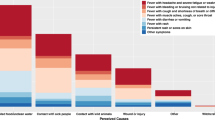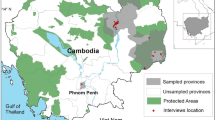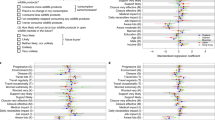Abstract
There has been much discussion in the conservation and policy realms of COVID-19 as a zoonotic disease, or a disease transmitted from wildlife to humans. However, wildlife consumption in China is not only a potential source of disease but also a practice embedded in complex beliefs about health. This paper used survey data (N = 974) collected in China in June 2021 to examine attitudes and behaviors related to (a) wildlife consumption, (b) Traditional Chinese Medicine (TCM) and (c) zoonotic risk after the emergence of the COVID-19 pandemic. 40.1% of respondents self-reported that they are less likely to consume wild animals since the outbreak of COVID-19. Respondents who used wildlife supplements for TCM, who believed in the benefits of wild animal consumption and fresh slaughter of wildlife, and who had higher levels of agreement with the zoonotic origin of COVID-19 were more likely to report that they had decreased their wildlife consumption after the outbreak of COVID-19. Use of wildlife in TCM significantly increased the odds that a respondent believed that COVID-19 was very likely zoonotic. We discuss how situating wildlife consumption within complex beliefs about health and disease can assist with protecting wildlife and public health in the wake of COVID-19.











Similar content being viewed by others
Data Availability
The data presented in this study are openly available in Harvard Dataverse at https://doi.org/10.7910/DVN/HEFW1Z.
Notes
As of 2006, China had 44 universities for TCM education, 166,614 TCM doctors, 21,324 TCM pharmacists, and 28,514 TCM doctors’ assistants who practiced in hospitals, and 33,574 TCM doctors and 7843 TCM doctors’ assistants who practiced in health clinics and community health service centers (Xu and Yang 2009).
Potential limitations due to language/translation issues were minimized through consultation with the bilingual member of our research team (based in China), in which we discussed how the survey questions would be viewed in a Chinese context and adjusted translations accordingly. Further, since the survey was based on quantitative responses rather than free responses, translation was not needed to interpret the data.
Demographic information included age, gender, highest level of education achieved, income, and occupation. Respondents were asked to identify their geographic location as “urban” or “rural,” and to enter their specific region (see Appendix S1).
This text read: “For the purpose of this survey, we define ‘wild animals’ as traditionally non-domesticated animals that are either farmed or caught from the wild. This includes all animals that are not chickens, cows, pigs, goats, or sheep. For example, frogs, snakes, bamboo rats, and crabs are considered wild animals, regardless of whether they are farmed or caught from the wild. We define ‘consumption’ in terms of general use for either food or medicine.”.
Qualtrics sent the survey to a total of 3,789 respondents (inclusive of the soft launch but not the pretests). Many of these respondents did not qualify, were over the quotas for age and gender specifications, or were screened out due to speeding through the survey or answering in an internally contradictory manner. A total of 1369 respondents were terminated because they were over quota (i.e., in an age range or gender category that had already met its quota) and 1236 respondents were terminated for targetable attributes (i.e., were younger than 20, were older than 79, were not located in China, or were screened out because of the supplemental quality control screeners implemented, including 68 respondents excluded due to the speed check). Qualtrics sends their surveys to such a wide audience that it is standard to have more respondents terminate than complete the survey, as occurred in this survey. This left a remaining sample of 1184 good completes. Since we added three additional survey questions after the soft launch, we removed the soft launch respondents from our sample, which left a final sample of 974 respondents.
These screens were designed to allow for a complexity in attitudes while removing respondents who answered the questions without reading/comprehending them. For example, this excluded respondents who said “No, I have never consumed wild animals” but then indicated consumption in a subsequent question or respondents who selected both an answer as well as “none of the above” within the same question.
While some of the dependent variables analyzed with binary logistic regression were drawn from questions that involved multiple (more than two) answers, the distribution of the categories was uneven and thus did not allow for multinomial logistic regression (e.g., the number of respondents in some categories was too small).
Correlations between potential sources of COVID-19 were all under 0.5; correlations between various species as potential transmitters of COVID-19 were all under 0.7, and the correlation between the perceived benefit of fresh slaughter and the perceived benefit of wildlife consumption was 0.4.
Data on China’s population as a whole (which included measures of gender, age, rural/urban residence, and income) were gathered from the China Statistical Yearbook, last collected in 2019: http://www.stats.gov.cn/tjsj/ndsj/2019/indexeh.htm.
This was confirmed through stratification. When only respondents with a pure protection cognition were selected, there was no significant difference in consumption between those who believed in COVID-19’s zoonotic origins and those who didn’t (Pearson chi-square 9.015, p = 0.003). Yet among respondents who held a conditional utilization or pure utilization cognition, people who believed in COVID-19’s zoonotic origins were more likely to report decreased consumption (Pearson chi-square 19.272, p < 0.001).
References
Ammann J, Egolf A, Hartmann C, Siegrist M (2020) Cross-national comparison of the Food Disgust Picture Scale between Switzerland and China using confirmatory factor analysis. Food Quality and Preference 79:103756
Bell, D, Roberton, S, Hunter, PR (2004) Animal origins of SARS coronavirus: possible links with the international trade in small carnivores. Philosophical Transactions of the Royal Society of London. Series B: Biological Sciences 359(1447): 1107–1114
Bengis RG, Leighton FA, Fischer JR, Artois M, Morner T, Tate CM (2004) The role of wildlife in emerging and re-emerging zoonoses. Revue Scientifique Et Technique-Office International Des Epizooties 23(2):497–512
Boas TC, Christenson DP, Glick DM (2020) Recruiting large online samples in the United States and India: Facebook, mechanical turk, and qualtrics. Political Science Research and Methods 8(2):232–250
Booth H, Clark M, Milner-Gulland EJ, Amponsah-Mensah K, Antunes AP, Brittain S, Castiljo LC, Campos-Silva JV, Constantion PDL, Li Y, Mandoloma L, Njeji LM, Iponga DM, Moyo B, McNamara J, Rakotonarivo OS, Shi J, Tagne CTK, van Velden J, Williams DR (2021) Investigating the risks of removing wild meat from global food systems. Current Biology 31(8):1788–1797
Broad, S (2020) Wildlife trade, COVID-19, and zoonotic disease risks. TRAFFIC. Available: https://www.traffic.org/site/assets/files/12764/covid-19-briefing-vfinal.pdf [accessed October 21, 2021]
Buceta J, Johnson K (2017) Modeling the Ebola zoonotic dynamics: Interplay between enviroclimatic factors and bat ecology. PLoS One 12(6):e0179559
Chee LP (2021) Mao’s Bestiary: Medicinal Animals and Modern China. Durham: Duke University Press
Chen W (2019) Indigenous knowledge systems: Practices in modern day China. In: Katerere DR, Applequist W, Aboyade OM, Togo C (eds) Traditional and Indigenous Knowledge for the Modern Era: A Natural and Applied Science Perspective Boca Raton: CRC Press, pp 117–127
Cheung H, Doughty H, Hinsley A, Hsu E, Lee TM, Milner-Gulland EJ, Possingham H, Biggs D (2020) Understanding Traditional Chinese Medicine to strengthen conservation outcomes. People and Nature 3(1):115–128
Fears R, Griffin GE, Larhammar D, ter Meulen V, van der Meer JWM (2020) Globalization of Traditional Chinese Medicine: what are the issues for ensuring evidence-based diagnosis and therapy? Journal of Internal Medicine 287(2):210–213
Ferreira MN, Elliott W, Kroner RG, Kinnaird MF, Prist PR, Valdujo P, Vale MM (2021) Drivers and causes of zoonotic diseases: An overview. Parks 27:15–24
Gatti RC (2020) The pangolin’s revenge: SARS-CoV-2 did not emerge from a lab but from wildlife exploitation. GAIA-Ecological Perspectives for Science and Society 29(2):79–82
Giri R, Bhardwaj T, Shegane M, Gehi BR, Kumar P, Gadhave K, Oldfield CJ, Uversky VN (2021) Understanding COVID-19 via comparative analysis of dark proteomes of SARS-CoV-2, human SARS and bat SARS-like coronaviruses. Cellular and Molecular Life Sciences 78(4):1655–1688
Golden CD, Wrangham RW, Brashares JS (2013) Assessing the accuracy of interviewed recall for rare, highly seasonal events: the case of wildlife consumption in Madagascar. Animal Conservation 16(6):597–603
Han, L, Lu, XQ, Liu, XW, Liao, MN, Sun, RY, Xie, Y, Liao, XP, Liu, YH, Sun, J, Zhang, RM (2021) Molecular epidemiology of fosfomycin resistant E. coli from a pigeon farm in China. Antibiotics 10(7): 777
Hemelaar J (2012) The origin and diversity of the HIV-1 pandemic. Trends in Molecular Medicine 18(3):182–192
Hilderink MH, de Winter II (2021) No need to beat around the bushmeat–The role of wildlife trade and conservation initiatives in the emergence of zoonotic diseases. Heliyon 7(7):e07692
IPBES (2020) Workshop Report on Biodiversity and Pandemics of the Intergovernmental Platform on Biodiversity and Ecosystem Services. Daszak, P., Amuasi, J., das Neves, C. G., Hayman, D., Kuiken, T., Roche, B., Zambrana-Torrelio, C., Buss, P., Dundarova, H., Feferholtz, Y., Földvári, G., Igbinosa, E., Junglen, S., Liu, Q., Suzan, G., Uhart, M., Wannous, C., Woolaston, K., Mosig Reidl, P., O’Brien, K., Pascual, U., Stoett, P., Li, H., Ngo, H. T., IPBES secretariat, Bonn, Germany. 10.5281/zenodo.4147317
IBM Corp (2019). IBM SPSS Statistics for Windows (Version 26.0). Armonk: IBM Corp
Jacob MCM, Feitosa IS, Albuquerque UP (2020) Animal-based food systems are unsafe: severe acute respiratory syndrome coronavirus 2 (SARS-CoV-2) fosters the debate on meat consumption. Public Health Nutrition 23(17):3250–3255
Kumar V, Pruthvishree B, Pande T, Sinha D, Singh B, Dhama K, Malik YS (2020) SARS-CoV-2 (COVID-19): Zoonotic origin and susceptibility of domestic and wild animals. J Pure Appl Microbiol 4(suppl 1):741–747
Li H, Daszak F, Chmura A, Zhang Y, Terry P, Fielder M (2021) Knowledge, attitude, and practice regarding zoonotic risk in wildlife trade, Southern China. EcoHealth 18:95–106
Liu J (2003) SARS, wildlife, and human health. Science 302(5642):53–54
Liu T, Li X, Zou ZY, Li C (2015) The prevalence and determinants of using Traditional Chinese Medicine among middle-aged and older Chinese adults: Results from the China health and retirement longitudinal study. Journal of the American Medical Directors Association 16(11):1002-e1
Li H, Mendelsohn E, Zong C, Zhang W, Hagan E, Wang N, Li S, Yan H, Huang H, Zhu G, Ross N, Chmura A, Terry P, Fielder M, Miller M, Shi Z, Daszak P (2019) Human-animal interactions and bat coronavirus spillover potential among rural residents in Southern China. Biosafety and Health 1(2):84–90
Li Z, Wang H (2021) Consumer behavior and wild animal consumption in China. The Chinese Economy 54(6):389–401
Lu M, Wang X, Ye H, Wang H, Qiu S, Zhang H, Liu Y, Luo J, Feng J (2021) Does public fear that bats spread COVID-19 jeopardize bat conservation? Biological Conservation 254:108952
Mizumoto K, Kagaya K, Chowell G (2020) Effect of a wet market on coronavirus disease (COVID-19) transmission dynamics in China, 2019–2020. International Journal of Infectious Diseases 97:96–101
Murray KA, Allen T, Loh E, Machalaba C, Daszak P (2016) Emerging viral zoonoses from wildlife associated with animal-based food systems: risks and opportunities. In: Jay-Russell M, Doyle MP (eds) Food Safety Risks From Wildlife Cham: Springer, pp 31–57
Naguib MM, Li R, Ling J, Grace D, Nguyen-Viet H, Lindahl JF (2021) Live and wet markets: food access versus the risk of disease emergence. Trends in Microbiology 29(7):573–581
Paige SB, Frost SD, Gibson MA, Jones JH, Shankar A, Switzer WM, Ting N, Goldberg TL (2014) Beyond bushmeat: Animal contact, injury, and zoonotic disease risk in Western Uganda. EcoHealth 11(4):534–543
Pang Z, Ren L, Wu S, Ma W, Yang J, Di L, Li J, Xiao Y, Kang L, Du S, Du J, Wang J, Li G, Zhai S, Chen L, Zhou W, Lai S, Gao L, Pan Y, Wang Q, Li M, Wang J, Huang Y, Wang J (2020) Cold-chain food contamination as the possible origin of COVID-19 resurgence in Beijing. National Science Review 7(12):1861–1864
Rizzolo JB (2021) Effects of legalization and wildlife farming on conservation. Global Ecology and Conservation 25:e01390
Rizzolo JB (2020) Wildlife farms, stigma, and harm. Animals 10(10):1783
Rocha R, Aziz SA, Brook CE, Carvalho WW, Cooper-Bohannon R, Frick WF, Huang JC, Kingston T, Lopez-Baucells A, Maas B, Matthews F, Medellin RA, Olival KJ, Peel AJ, Plowright RK, Razgour O, Rebelo H, Rodrigues L, Rossiter SJ, Russo D, Straka TM, Teeling EC, Treuer T, Voigt CC, Webala PW (2020) Bat conservation and zoonotic disease risk: a research agenda to prevent misguided persecution in the aftermath of COVID-19. Animal Conservation. https://doi.org/10.1111/acv.12636
Saylors KE, Mouiche MM, Lucas A, McIver DJ, Matsida A, Clary C, Maptue VT, Euren JD, LeBreton M, Tamoufe U (2021) Market characteristics and zoonotic disease risk perception in Cameroon bushmeat markets. Social Science & Medicine 268:113358
Si R, Lu Q, Aziz N (2021) Impact of COVID-19 on peoples’ willingness to consume wild animals: empirical insights from China. One Health 12:100240
Shi Z, Hu Z (2008) A review of studies on animal reservoirs of the SARS coronavirus. Virus Research 133(1):74–87
Shivaprakash KN, Sen S, Paul S, Kiesecker JM, Bawa KS (2021) Mammals, wildlife trade, and the next global pandemic. Current Biology 31(16):3671–3677
Turcios-Casco MA, Gatti RC (2020) Do not blame bats and pangolins! Global consequences for wildlife conservation after the SARS-CoV-2 pandemic. Biodiversity and Conservation 29(13):3829–3833
Van Uhm D, Zaitch D (2021) Defaunation, wildlife exploitation and zoonotic diseases: a green criminological perspective. In: Siegel D (ed) Notes from Isolation: Global Criminological Perspectives on Coronavirus Pandemic Netherlands: Eleven International Publishing, pp 11–30
Wang W, Yang L, Wronski T, Chen S, Hu Y, Huang S (2019) Captive breeding of wildlife resources—China’s revised supply-side approach to conservation. Wildlife Society Bulletin 43(3):425–435
Wang LF, Eaton BT (2007) Bats, civets and the emergence of SARS. In: Childs JE, Mackenzie JS, Richt JA (eds) Wildlife and Emerging Zoonotic Diseases: The Biology, Circumstances and Consequences of Cross-Species Transmission Berlin: Springer, pp 325–344
Wilkie DS, Wieland M, Boulet H, Le Bel S, van Vliet N, Cornelis D, BriacWarnon V, Nasi R, Fa JE (2016) Eating and conserving bushmeat in Africa. African Journal of Ecology 54(4):402–414
Williamson EM, Lorenc A, Booker A, Robinson N (2013) The rise of traditional Chinese medicine and its materia medica: A comparison of the frequency and safety of materials and species used in Europe and China. Journal of Ethnopharmacology 149(2):453–462
Xiao L, Lu Z, Li X, Zhao X, Li BV (2021a) Why do we need a wildlife consumption ban in China? Current Biology 31(4):R168–R172
Xiao X, Newman C, Buesching CD, Macdonald DW, Zhou ZM (2021b) Animal sales from Wuhan wet markets immediately prior to the COVID-19 pandemic. Scientific Reports 11(1):1–7
Xu J, Yang Y (2009) Traditional Chinese medicine in the Chinese health care system. Health Policy 90(2–3):133–139
Xu Y, Song Y, Cai J, Zhu H (2021) Population mapping in China with Tencent social user and remote sensing data. Applied Geography 130:102450
Zhang L, Hua N, Sun S (2008) Wildlife trade, consumption and conservation awareness in southwest China. Biodiversity and Conservation 17(6):1493–1516
Zhang L, Yin F (2014) Wildlife consumption and conservation awareness in China: a long way to go. Biodiversity and Conservation 23(9):2371–2381
Zhang Z, Yang T, Hu Y, Cirella GT, Xie Y (2022) Behavioral intention to resist the consumption of wild animals in China: Netizen survey. Diversity 14(5):343
Zhu A, Chen R, Rizzolo JB, Li X (2023a) The politicization of COVID-19 origin stories: Insights from a cross-sectional survey and media review in China. Societies 13(2):37
Zhu AL, Chen R, Rizzolo J, Qian J (2023b) Perceptions of COVID-19 origins and China’s wildlife policy reforms. Global Ecology and Conservation 43:e02463
Zhu A, Zhu G (2020) Understanding China’s wildlife markets: Trade and tradition in an age of pandemic. World Development 136:105108
Funding
The authors have no funding sources to report.
Author information
Authors and Affiliations
Corresponding author
Ethics declarations
Conflict of interest
The authors declare that they have no conflict of interest.
Ethical Approval
All procedures performed in studies involving human participants were in accordance with the ethical standards of the institutional and/or national research committee and with the 1964 Helsinki declaration and its later amendments or comparable ethical standards. The study was approved by the ethics committee of Michigan State University’s Institutional Review Board (Study Number 00005583).
Informed Consent
Informed consent was obtained from all individual participants included in the study.
Supplementary Information
Below is the link to the electronic supplementary material.
Rights and permissions
Springer Nature or its licensor (e.g. a society or other partner) holds exclusive rights to this article under a publishing agreement with the author(s) or other rightsholder(s); author self-archiving of the accepted manuscript version of this article is solely governed by the terms of such publishing agreement and applicable law.
About this article
Cite this article
Rizzolo, J.B., Zhu, A. & Chen, R. Wildlife Consumption, Health, and Zoonotic Disease in China After the Emergence of COVID-19. EcoHealth 20, 323–342 (2023). https://doi.org/10.1007/s10393-023-01651-w
Received:
Revised:
Accepted:
Published:
Issue Date:
DOI: https://doi.org/10.1007/s10393-023-01651-w




